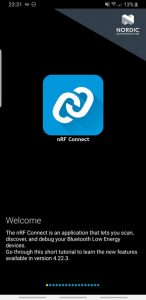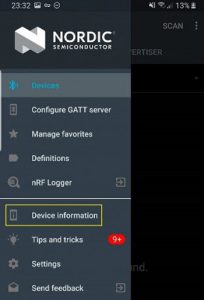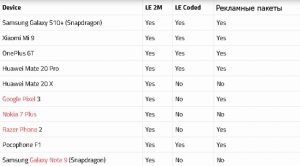 It is hard to imagine a modern smartphone without Bluetooth (remember, this is a standard for wireless file transfer from one device to another). Every couple of years, a new version of this technology is released, the latest of which was Bluetooth 5, announced back in 2016. Although most modern smartphones support Bluetooth 5, it's hard to find a device that takes advantage of all the key features of the fifth generation Bluetooth.
It is hard to imagine a modern smartphone without Bluetooth (remember, this is a standard for wireless file transfer from one device to another). Every couple of years, a new version of this technology is released, the latest of which was Bluetooth 5, announced back in 2016. Although most modern smartphones support Bluetooth 5, it's hard to find a device that takes advantage of all the key features of the fifth generation Bluetooth.
In Bluetooth 5, the data transfer rate and range were significantly increased, but for Bluetooth 5, support for all its features is not required. Therefore, do not be surprised if you buy a smartphone with “support” Bluetooth 5, and after a while you will find out that your device does not support the main features of the new generation Bluetooth.
New physical (PHY) levels
One of the main features of Bluetooth 5 is the new physics levels. For a device to support 5th Bluetooth, it must support LE 1M (used in Bluetooth 4), which means a data transfer rate of 1 Mb / s.
In Bluetooth 5, a new LE 2M level has appeared, as a result of which the speed has doubled (2 Mb / s). Another level was also added: LE Coded, providing a much larger range than in Bluetooth 4 (4 times). According to official statements, this will not affect energy consumption in any way.
Interestingly, for Bluetooth 5 to work, support for these levels is optional. Today, the vast majority of devices with support for Bluetooth 5 support only one of the new levels, so you will have to try to find a smartphone that supports both levels (LE 2M + LE Coded).
to the content
Advertising packages
In Bluetooth 5, the length of advertising packages required for synchronization between a smartphone / tablet and a headset was increased. Advertising packages are a set of data that your device transmits to another device when it tries to connect.
Longer ad packets mean your device can send and receive more data from another device. The so-called beacons are responsible for the transmission of data packets.
Beacons are the simplest radio transmitter that can be used for both data transmission and navigation. For example, walking through the park, you can get information about this park and its attractions. In Bluetooth 4, the maximum ad packet length is 37 octets (bytes). In Bluetooth 5, the packet length was significantly increased – up to 255 bytes.
However, these speeds are not required to operate Bluetooth 5. The big disadvantage is that Bluetooth 4 will not be able to accept packets longer than 37 bytes. So technologies (or rather, phones with different versions of bluetooth) are not compatible with each other.

Therefore, do not be surprised if the manufacturer declares support for Bluetooth 5, but without support for the three main features of the new Bluetooh, it will practically not differ from the fourth generation. In addition to the increased data transfer rate and the distance at which Bluetooth will continue to work, several other wireless features have been improved: the amount of interference that occurs when two devices are synchronized has been reduced, and much more.
to the content
Which phones support Bluetooth 5?
You can use the nRF Connect for Mobile app to check if your device supports the key features of 5th generation wireless connectivity. The application is available for download on the Play Store.
After installing the application – launch it. At the first launch, the application will give you a few introductory messages that you can just skip.

Then click “OK” to allow the application to copy the files to your device.

This must be done for the application to work correctly. Now, click on the button in the upper left corner of the screen (three horizontal stripes). In the menu that opens, tap on “Device Information”.

You should be presented with a list of various features, by which you can understand whether your device supports these features or not. If opposite “High speed (LE 2M) supported” is “YES”, then your device supports the transmission of advertising data packets at a speed of 2 Mb / s (only for Bluetooth 5). If opposite “Long range (PHY Coded) supported” is “YES”, then your smartphone supports Bluetooth 5 operation at a distance of up to 100 meters. If next to “Extended advertisement supported” is “YES”, then your device is capable of receiving data packets up to 255 bytes long (only for Bluetooth 5).

Today, a very small number of flagships support all three main features Bluetooth 5. This is likely to change with the release of new flagships, as happened with Samsung smartphones. While the Samsung Galaxy S9 + only supported LE 2M, the Galaxy S10 + supports three at once. The flagships Xiaomi and OnePlus also support all three new features. Even the cheapest flagship devices like the POCO F1 support all the Bluetooth 5 features, so the price isn't the issue.
It is very strange that Samsung added support for all functionality Bluetooth 5 only in the Samsung Galaxy S10. Usually, this company is one of the first to try to use new technologies in their gadgets. It's no less surprising that OnePlus added support for all the new features of the new Bluetooth at once, given the fact that this company does not like to rush to use new technologies in its devices. As for Xiaomi, there is nothing surprising. This company tends to try to use as many new technologies as possible in their devices. However, some users were surprised that they added full support for Bluetooth 5 given their doubts about adding the Camera2 API technology.

It is a pity that only a few devices support all the functions of Bluetooh 5. According to users, less than 1% of devices have full support Bluetooth 5. The number of such devices is so small that they can be counted on one hand. Let's hope that with the release of new flagships in 2019-2020, there will be many more smartphones with full support Bluetooth 5 in the mobile market.
Bluetooth 5 is a big step forward in wireless, so it’s very strange to realize that the vast majority of manufacturers are in no rush to implement full support for all Bluetooth 5 features in their devices. What do you think, is Bluetooth 5 really necessary today?
